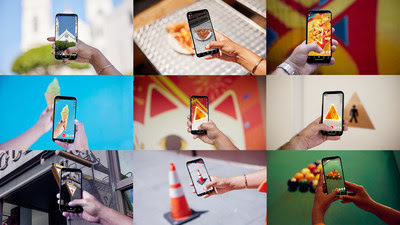The global augmented reality and virtual reality market is expected to be valued at $454.7 billion by the end of the decade, which translates to an annual compound growth rate of 40.7%,, driven by high-speed internet penetration and gaming, according to a report published in Valuates Reports.
There’s been a range of examples of how brands are incorporating augmented reality into campaigns recently and that trend looks like it will only continue.
AR boosts consumer connections, purchases
Augmented reality experiences help consumers feel 14% more connected to a brand, when compared to a pre-roll ad, according to a study by Magna Media Trials, cited by Marketing Magazine Australia.
The research found brand awareness and memorability were boosted by interactive and fun AR lenses, gamified entertainment lenses enhanced brand image and shoppable lenses encouraged conversions
“The fact that consumers noted utility and usefulness alongside an increase in purchase intent has confirmed AR’s ability to help drive decision-making in the purchase journey,” noted Magna’s Hannah Rook.
How brands are leveraging AR
AT&T recently teamed with Meta to use its Group Effects AR tool and give customers the chance to relive their love of the classic “snake” Nokia mobile game with a new version named Warp Speed Worm, according to this Fast Company article.
The activation not only connected with consumers through gamification, entertainment and nostalgia, but also showcased the capabilities of AT&T’s 5G network and spurred more sign ups to its mobile plans.
“It’s been really interesting to see how 5G can really increase the depth of immersion and what’s possible with AR and to see that customers love it,” AT&T’s Igor Glubochansky told Fast Company.
Doritos just bet big on the technology with a national campaign that centers around a “Triangle Tracker” AR Snapchat lens, which transforms triangles in the real world into one of the brand’s chips. Every time the lens is used, Snapchatters will receive a code to win a range of prizes, with a top award of $250,000. The push incorporates TikTok, Roblox and out-of-home activations.
The Doritos campaign is one of the most extensive augmented reality campaigns out there, and parent company PepsiCo has been experimenting for a while, including a joint campaign with Pizza Hut that enabled soccer fans to play as Manchester United star Paul Pogba.
Rafael Belloso, senior brand marketing manager at Ocean Spray Cranberries, talks in this Portada article about how the brand boosted awareness in Chile with an AR-driven packaging campaign that allowed customers to unlock games and product information.
“The amount of interaction and engagement you can get from the technology is huge,” Belloso says, adding that another bonus is cost effectiveness. “It isn’t that big of an investment, it depends on how big the experience you want the augmented reality to be, but compared to other budgets in marketing it is not big.”
Chiwei Lee, head of tech, telco and entertainment at Meta’s Creative Shop, believes the democratization of augmented and virtual reality technology through social media tools is leading to exciting new opportunities that brands are eager to embrace.
“These tools aren’t only to drive discovery but also to drive meaningful discovery,” Lee told Fast Company. “It’s not just seeing the ad, but having the ad pull you in and allow you to have this deeper experience. That’s how brands and marketers should be thinking about these kinds of tools.”
Subscribe to our free newsletter to get the latest marketing news and insights direct to your inbox.
